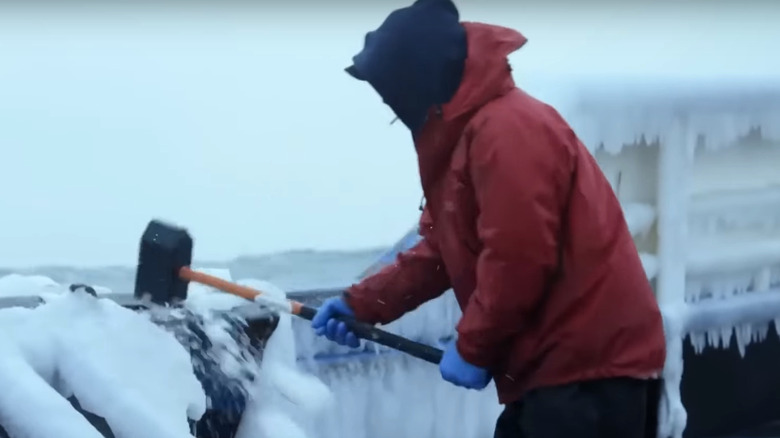Why Ice Is Such A Nightmare For The Deadliest Catch Crew
Fishermen fight against storms and terrible waves on a regular basis as they navigate the oceans searching for fish. However, "Deadliest Catch" crews and other crabbers have to face another danger as well, and that's ice. King crab season near Alaska is between October and January when waters are cold and ice is common. Cold water is already an issue due to its potential to quickly drown crewmates should they end up overboard, but icy conditions make things even worse.
On "Deadliest Catch," you see this threat appear a few times, leading to captains having to call it quits on crabbing or spend hours trying to break the ice off of their equipment. Making the right call when dealing with this threat is important. A captain making a wrong decision in the middle or the night, or while trying to balance safety and speed can quickly find themselves and their crew fighting for their lives.
Ice makes for slippery conditions
Boats are already a slippery place to be, and ice only exasperates the danger. An icy deck makes it much easier for a crew member to fall into the water, especially at night. Falling into the water is one of the most common ways people die while fishing, especially in cold waters where even expert swimmers are overcome by the cold, uncontrollably gasping and hyperventilating from the shock.
Rodney Avila is a member of the New England Fisheries Management Council and knows a lot about the dangers of ice on a boat. During an interview with South Coast Today, he mentioned the most dangerous times to handle ice is when its coldest, which is usually between midnight and five in the morning according to Rodney. "No captain wants to send his crew out in the middle of the night on an icy deck to break up ice. That's when you can lose a man overboard."
Capsizing and profit loss are also potential dangers
The second threat is the risk of capsizing. Ice is heavy. During an exclusive interview with Viera Voice, Edgar Hansen from "Deadliest Catch," explained how that effects the boats. "They say every inch of ice is worth a quarter-inch plate of steel. So when you're talking two, three feet of ice, you can imagine how much heavier that boat really is."
When this heavy ice is paired with strong winds, there's a heavy risk of capsizing, such as in 2017 when the vessel Destination was crabbing near Alaska, according to Maritime Injury Center. Most of the time, hammers or other tools like baseball bats are used to break the ice. According to Edgar during his interview, it often takes several hours to break, and that's if it's not actively still icing up.
It's not only the risk of injury or death that makes ice a pain. Ice can also cause harm to profits, not only by slowing down the boat but sheets of ice on the water can move around crab pots, which take a long time to find again. Flipped pots may also kill the crabs inside the pot, causing teams to lose out on money. Edgar described these moments as such, "It's like getting a flat tire on your way to work when you're already late for work."


